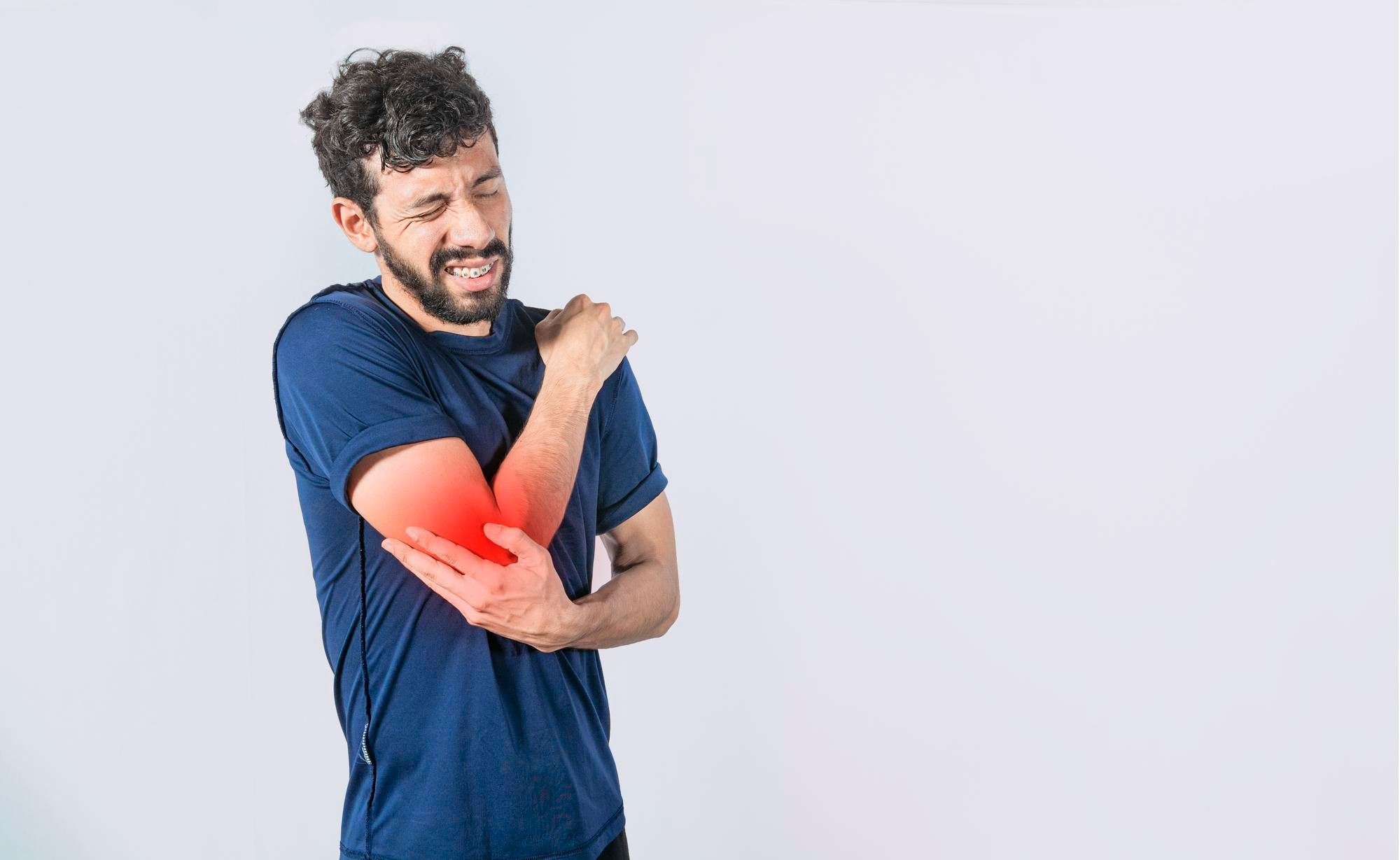
A middle-aged man holding her elbow in pain.
If you find your knees, hips or shoulders a little stiffer and achier since your 40th birthday, you're far from alone. Joint pain is one of the most common complaints among adults in their 40s and beyond. Though an occasional twinge can be normal, persistent pain can interfere with everything from climbing stairs to exercising to simply sitting comfortably.
Understanding why joint pain becomes more common with age can help you take proactive steps to protect your mobility and maintain a healthy, active lifestyle.
Your joints, the connections between bones, rely on cartilage, synovial fluid, muscles and ligaments to provide a smooth functioning of the joints. As natural wear and tear starts, these various components begin to deteriorate.
In your 40s, you may notice:
This combination can leave your joints more prone to pain, inflammation and injury, especially if you've lived a relatively sedentary lifestyle or repeatedly used the same movements for many years.
Osteoarthritis is a degenerative joint condition caused by gradual cartilage breakdown and it is the most frequent cause of joint pain after 40.
This usually affects knees, hips, lower back and hands, resulting in:
While it cannot be fully reversed, early management can slow the progression and relieve discomfort.
After age 40, muscle mass naturally decreases, a process known as sarcopenia. Weaker muscles mean less support for joints, therefore more strain and pain.
Tip: Regular strength training and physical activity help maintain muscle tone and protect your joints.
Decreased levels of estrogen during perimenopause and menopause can cause joint stiffness and inflammation in women. Estrogen helps to maintain good cartilage and fluid balance so a decline in these levels fosters aches and reduced flexibility.
Men may experience similar effects of low testosterone, which impacts muscle maintenance and bone density.
Past injuries or strains from sporting activities that were not properly treated may recur later in life. Scar tissue, joint instability or misalignment from older injuries can cause a lot of pain years later particularly in the knees and shoulders.
Prolonged sitting as well as lack of physical activity weaken the muscles and ligaments that support joints. This decreases flexibility while increasing stiffness especially in the hips, knees and lower back. Gentle movement throughout the day keeps blood flowing to joints and nourishes cartilage.
Even a few extra kilograms can exert considerable pressure on the weight-bearing joints such as the knees and hips. For instance, with every additional 5 kg comes an approximate increase of 20 kg of pressure to the knees upon walking. Maintaining a healthy weight greatly reduces stress on joints and lowers the risk of arthritis.
Poor posture over the years, heavy lifting and repetitive motions may cause misalignment and lead to chronic strain on the joints.
Common examples include:
Correcting posture and proper movement techniques serve to prevent long-term problems with joints.

A man sitting at his desk with his neck and shoulders slouched forward.
Not all joint pain emanates from wear and tear. Various autoimmune conditions such as rheumatoid arthritis, lupus and gout are capable of causing inflammation, swelling and damage to your joints at any age but may only first appear or worsen after age 40.
If you have any of the following symptoms, avail yourself of an early evaluation:
Early diagnosis enables timely treatment and prevents further damage for maintaining mobility.
Low-impact exercises like swimming, yoga and cycling strengthen muscles without stressing joints. Regular movement lubricates joints and improves flexibility.
A balanced diet and regular exercise reduce strain in the joints and minimize inflammation.
Stronger muscles around your joints, especially core and leg muscles, will improve stability and prevent injuries.
Include foods rich in omega-3 fatty acids, vitamin D, calcium and antioxidants such as:
Limit or avoid foods that may cause inflammation such as processed foods, sugar drinks and excess alcohol.

A well-balanced diet plan.
Keep your spine neutral, shoulders relaxed and weight evenly balanced while sitting, standing or lifting. Small posture corrections prevent chronic strains.
Sleep is a time when your body heals tissues, including cartilage. Poor sleep increases pain perception and inflammation.
Treatment for joint pain may include the following, depending on the cause and severity:
A proper treatment plan aims at pain alleviation and the return of daily function.
At Prakash Hospital, a team of orthopedic specialists, physiotherapists and rehabilitation experts gives priority to the early detection and management of joint pain. Advanced imaging and personalized treatment programs target the root cause, whether it's arthritis, hormonal chane or lifestyle factors.
From pain relief therapies to joint preservation techniques, the goal is to keep patients active, mobile, and pain-free well into their 40s, 50s and beyond.
You can't stop the aging process but you can slow down joint wear and tear with the right habits:
These small daily choices go a long way toward ensuring lifelong joint health.
After the age of 40, joint pain is common, but far from inevitable. Most cases result either from gradual wear, hormonal shifts or lifestyle habits that can be corrected with awareness and care. Staying active, eating well, good posture and advice from doctors when needed all go a long way in protecting your joints to keep you living life with energy and ease. At Prakash Hospital, we believe age should never limit movement, with the right care, you can stay strong, flexible and pain-free at any age.
We offer expert care across key specialties, including Medicine, Cardiology, Orthopaedics, ENT, Gynaecology, and more—delivering trusted treatment under one roof.
Prakash Hospital Pvt. Ltd. is a 100 bedded NABH NABL accredited multispecialty hospital along with a center of trauma and orthopedics. We are in the service of society since 2001.
OUR SPECIALITIES
Contact Us
D – 12A, 12B, Sector-33, G. B. Nagar, Noida, Uttar Pradesh 201301
+91-8826000033

© 2025 All rights reserved.
Designed and Developed by Zarle Infotech